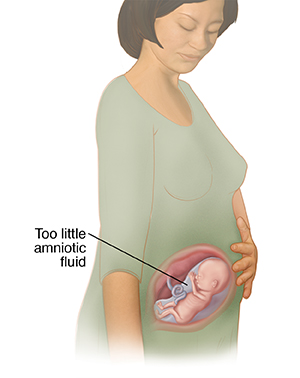Oligohydramnios
Amniotic fluid surrounds the baby and protects it as it develops. It also helps the baby’s muscles, lungs, and digestive tract develop correctly. Your healthcare provider has found that you have too little amniotic fluid in your uterus. This is called oligohydramnios. When this condition is found, it changes the way the pregnancy is managed, even if the pregnancy is otherwise healthy. Low fluid makes the pregnancy complicated. In an otherwise healthy pregnancy, the problem may not need treatment.

Causes of oligohydramnios
This condition is most common during the last trimester and in pregnancies carried beyond term. This is because amniotic fluid levels naturally decline after 41 weeks. If the problem happens earlier in pregnancy, it may be due to a health problem in the birth parent or the baby. If diagnosed, it would be important to find out if your amniotic sac has broken. But often the cause of the low fluid levels is not known.
Diagnosing oligohydramnios
An ultrasound is done to measure the amount of amniotic fluid in the uterus. The ultrasound uses sound waves to create detailed images of the inside of the uterus. During the ultrasound test, the amount of amniotic fluid is measured, most often through a method called amniotic fluid index (AFI). Oligohydramnios is considered present if the AFI shows a fluid level less than 5 centimeters.
Managing oligohydramnios
In some cases, drinking more fluids can help increase the level of amniotic fluid. Beyond that, your health and the health of your baby is checked. You will have regular ultrasounds to keep track of your amniotic fluid level. Fetal stress tests may also be done. These tests check the unborn baby’s health. In many cases, no treatment is needed. If your healthcare provider decides that treatment is needed, it may include:
-
Bed rest at home or stay in the hospital. During this time, your health and your baby's health are watched closely.
-
IV fluids. A tube put into the arm or hand is used to give the birth parent fluids.
-
Amnioinfusion. This increases the amount of fluid in the uterus by adding (infusing) sterile saltwater (saline solution). It can only be used during labor and delivery.
-
Induction of labor. This may be done if the pregnancy is at term or beyond. Your healthcare provider will tell you more about this if it is needed.
Follow-up care
If you or your baby has a condition that has caused the low amniotic fluid level, the condition will be treated. Your healthcare provider can tell you more about the cause of your low amniotic fluid level. They can also discuss treatment choices with you.
When to call your healthcare provider
Call your healthcare provider right away if any of these occur:
-
Fever of 100.4°F (38°C) or higher, or as advised by your provider
-
Sudden or severe belly (abdominal) cramping
-
Fluid leaking from the vagina
-
Regular, rhythmic contractions
-
Baby moving less than before
Online Medical Reviewer:
Donna Freeborn PhD CNM FNP
Online Medical Reviewer:
Heather M Trevino BSN RNC
Online Medical Reviewer:
Irina Burd MD PhD
Date Last Reviewed:
11/1/2022
© 2000-2025 The StayWell Company, LLC. All rights reserved. This information is not intended as a substitute for professional medical care. Always follow your healthcare professional's instructions.